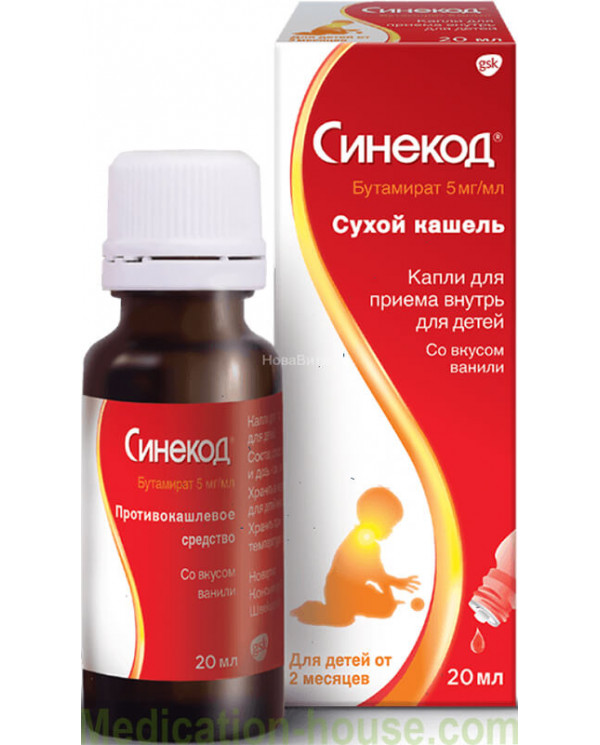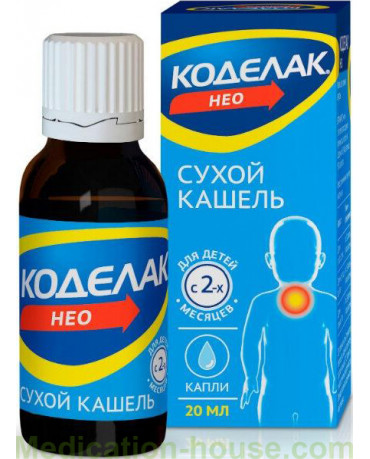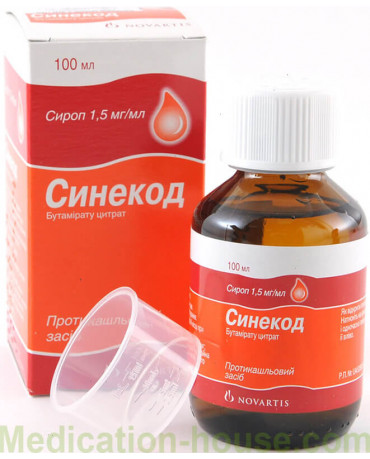Instruction for Sinecod
Reed more and buy Sinecod on this page
Release form and composition
Droplets for oral administration (for children): a clear liquid, colorless or with a yellowish tinge, with the smell of vanilla (20 ml in dark glass bottles equipped with a dropper-dispenser and a control system for the first opening, in a pack of cardboard 1 bottle).
The active substance is butamirate citrate:
1 ml drops - 5 mg.
Additional components of the drops: sorbitol solution 70%, ethanol 96%, benzoic acid, sodium saccharin, glycerol, sodium hydroxide 30%, vanillin, water.
Pharmacodynamics
The active component of Sinecod is butamirate, which is part of the central group of antitussive drugs. This substance does not apply to opium alkaloids from either a chemical or pharmacological point of view and does not lead to the formation of addiction or dependence.
Butamirate suppresses cough by directly affecting the cough center. The synecode is characterized by a bronchodilating (bronchodilating) effect and facilitates breathing, improving blood oxygenation (oxygen saturation) and spirometry (airway resistance decreases).
Pharmacokinetics
The butamirate ester is rapidly and almost completely absorbed and hydrolyzed in plasma to form diethylaminoethoxyethanol and 2-phenylbutyric acid. Studies regarding the relationship of food intake and absorption of the active substance of Sinecod have not been conducted. When taking doses of 22.5–90 mg, the content of diethylaminoethoxyethanol and 2-phenylbutyric acid changes in direct proportion to the amount of the drug taken.
Butamirate is determined in the blood after 5-10 minutes after oral administration of doses of 22.5, 45, 67.5 and 90 mg. With a treatment regimen that includes taking the drug in any of the above dosages, the maximum plasma concentration is reached within 1 hour. When an oral dose of 90 mg is taken, the content of butyrate in the blood is 16.1 ng / ml.
The average plasma level of 2-phenylbutyric acid is reached within 1.5 hours. The maximum substance content of 3052 ng / ml was observed after taking a dose of 90 mg. The average plasma concentration of diethylaminoethoxyethanol is achieved within 0.67 hours at a maximum concentration of 160 ng / ml, recorded after taking a dose of 90 mg.
Butamirate is characterized by a large distribution volume in the range 81–112 L (it is necessary to take into account the correction for body weight in kg), and also almost completely binds to plasma proteins. 2-phenylbutyric acid is characterized by a high degree of binding to plasma proteins at all dosage levels (22.5–90 mg). On average, it varies in the range of 89.3–91.6%. Diethylaminoethoxyethanol binds to plasma proteins by 28.8–45.7%. Accurate data on whether butamirate crosses the placental barrier or into breast milk is not available.
The hydrolysis rate of butamirate is extremely high. The 2-phenylbutyric acid resulting from this process is also subsequently partially metabolized by hydroxylation in the para position.
All metabolites are excreted mainly through the kidneys. Those that have an acid reaction, after conjugation in the liver, mainly bind to glucuronic acid. The content of 2-phenylbutyric acid conjugates in urine is significantly higher than in blood plasma. Butamirate is detected in urine within 48 hours after taking Sinecod. With a 96-hour sampling period, the substance excreted in the urine accounts for approximately 0.02, 0.02, 0.03 and 0.03% of the doses taken of 22.5, 45, 67.5 and 90 mg, respectively .
Butamirate is excreted in the urine mainly in the form of diethylaminoethoxyethanol, the level of which is much higher than unconjugated 2-phenylbutyric acid or butamirate unchanged.
The half-life of butamirate, 2-phenylbutyric acid and diethylaminoethoxyethanol is 1.48–1.93, 23.26–24.42 and 2.72–2.9 hours, respectively.
Indications for use
The synecode is used for the symptomatic treatment of dry cough of various etiologies: with whooping cough, during bronchoscopy and surgical interventions, if necessary, suppressing cough in the pre- and postoperative period.
Contraindications
I trimester of pregnancy;
lactation period;
children's age up to 2 months;
hypersensitivity to the components of the drug.
Precautions: II and III trimesters of pregnancy.
Instructions for use Sinecod: method and dosage
The drug must be taken orally before meals.
Recommended doses of Sinecod drops for children, depending on age:
2-12 months - 10 drops 4 times a day;
1-3 years - 15 drops 4 times a day;
older than 3 years - 25 drops 4 times a day.
The duration of therapy is no more than 7 days.
If treatment is required for children under 2 years of age, consult a doctor.
Side effects
The drug is predominantly well tolerated. In rare cases (> 1/10 000, <1/1000), the following side effects occur:
from the central nervous system: drowsiness, dizziness;
from the digestive system: diarrhea, nausea;
on the part of the skin: exanthema;
others: allergic reactions.
Overdose
Symptoms of an overdose are: nausea, vomiting, drowsiness, diarrhea, dizziness, a sharp decrease in blood pressure. There is no specific antidote. Overdose treatment consists of gastric lavage, the appointment of activated charcoal and therapy that supports the vital functions of the body.
special instructions
During treatment, you should not take expectorant drugs, because this can lead to accumulation of sputum in the airways and, as a result, the development of respiratory infections and bronchospasm.
According to the instructions, Sinecod can cause drowsiness, which should be taken into account for drivers of vehicles and patients working in potentially hazardous industries associated with increased concentration of attention.
Pregnancy and lactation
Reliable clinical studies of the safety and effectiveness of Sinecod for pregnant women have not been conducted, therefore, it is not recommended to prescribe the drug in the first trimester of pregnancy. In the II and III trimesters, the use of Sinecod is allowed if the benefits to the mother outweigh the potential risk to the fetus.
Since there is no data on the release of butamirate with breast milk, taking the drug during lactation is undesirable.
Animal studies have not revealed toxic effects of butamirate on the fetus.
Use in childhood
For children, Sinecod is contraindicated: under the age of 2 months - in the form of drops.
Terms and conditions of storage
Store at temperatures up to 30 ° C out of the reach of children.
Shelf life is 5 years.
Reviews
Reviews about Sinecod in the form of syrup are mostly favorable. Patients indicate that it really helps with a dry cough, with no serious side effects. Many doctors prescribe this drug, which, with the right scheme, determines the positive dynamics of the disease.
Opinions about the drops are contradictory. Some patients claim that the drug was indispensable in the treatment of coughing attacks, others insist that it only suppresses cough, but does not cure it.
Terms of sell
You don't need a prescription to buy Sinecod.



